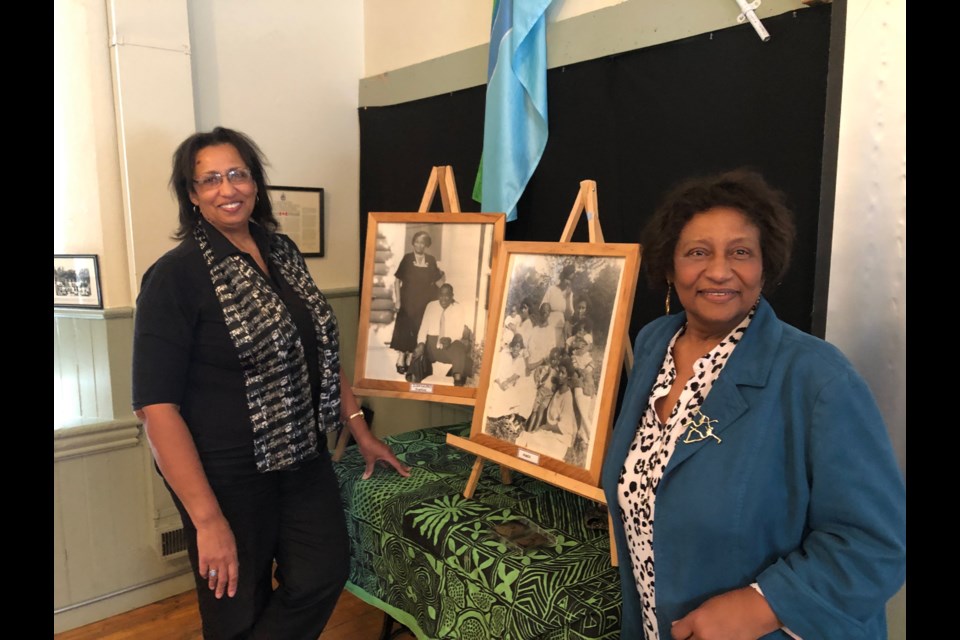This Black History Month, two local women hope to shed light on the stories of Black people before they were slaves.
Sylvia Wilson, who co-owns and operates the Sheffield Park Black History Museum in Clarksburg with her sister Carolynn Wilson, has been posting stories of Black Pharaohs and Queens this week for the museum’s Facebook page.
“A lot of times, people think the stories of Black Canadians, or even just Black people in general, start with slavery,” said Sylvia. “Like when we hit the Western coast, our stories began.”
But at the Sheffield Park Black History and Cultural Museum, the stories begin at the beginning.
“With Africa, with the African villages, their skills and talents over there that they brought with them when they became enslaved people,” added Sylvia.
Last week the museum page featured photos and excerpts donated by Dr. David Milburn and collected by Dr. Milburn’s father in Egypt.
“Egypt was a Black country,” said Sylvia. “Black people came from being pharaohs and royalty and having their own governments, and that was taken away.”
She has been featuring the stories of people such as Amenhotep III, often called Sun King, who reigned in 1400 BC as part of a lineage that ruled Egypt for 150 years. The Sun King was known for building man-made lakes and harbours for trading by ships.
Queen Tye, one of Amenhotep III’s wives was trusted with great responsibility and is believed to be the first Egyptian queen to sign official documents.
Queen Nefertiti became a co-regent, female pharaoh with the same powers as her male counterparts after the death of her husband Pharaoh Akhenaton. She was also stepmother to the famous King Tut (Tuthankaton).
Imhotep, born in 2650 as a commoner, rose to second in command as a vizier to Pharaoh Djosier, and is regarded as a historical genius, having performed surgeries, set fractures, treated infections and disease, and founded a school of medicine. He also was accomplished in architecture (designed the pyramid of Djoser) and legend said he created the plans for the pyramids at Giza to reflect the three stars of Orion’s belt from the Orion constellation.
Sylvia wants others to realize Black history from the beginning is full of intelligent people who were thinking, navigating, travelling, and learning. They carried those skills and talents with them as they eventually arrived in Canada. And have used generations of skills and knowledge to contribute to Canada's history and growth.
“Here we are now in the 21st century celebrating things like the first Black MP,” said Sylvia. “We’ve had the knowledge, we just haven’t had the opportunities.”
Both the Wilson sisters and others have spent much of their lives trying to gather and document Black history, but it’s been an “uphill battle.”
Missing pieces of history as a result of the slavery and racism in both Canada and the US have made it sometimes harder to find out about the Black people who lived in 1800 AD than it is to find the stories of Black people who lived in 1800 BC.
“That’s part of our failure in Canadian history, we don’t have the documentation,” said Sylvia.
For example, Sylvia and Carolynn and several other area elders believe Black settlers lived in Priceville (near Flesherton) since the early 1800s.
“People ask, ‘where’s the proof they were there?’” said Sylvia. “But surveyors didn’t come through until the 1930s or 40s … who was going to go to the Black settlers to say, we’re here to survey your land and put your name on a piece of paper? It didn’t happen.”
There are groups trying to recover the gravestones for what was once a Black pioneer cemetery that got ploughed into a farmer’s field.
“The cemeteries are gone and we’re trying to find them and people ask ‘why do you want to go through that when it happened a long time ago?’” said Sylvia. “White people can go to their cemeteries and honour their ancestors, we can’t.”
She said they and others are working to prove the Black settlers were in Priceville by finding the cemeteries and the gravestones, and reading the names on the stones.
“We have to prove who we are all the time, or where we are, or what we’re saying is true,” said Sylvia.
During a presentation hosted by the Simcoe County Museum on Feb. 7, Carolynn and Sylvia were asked what their hope is for the preservation and awareness of Black history seven generations from today.
They both dream of a place with extensive archives of Black history, and many places across Canada to mark the stories and important events and people from history.
“A place where people could go and say ‘yeah, they were there,’” said Carolynn.
You can follow the regular posts by the Sheffield Black History and Cultural Museum on Facebook here.



